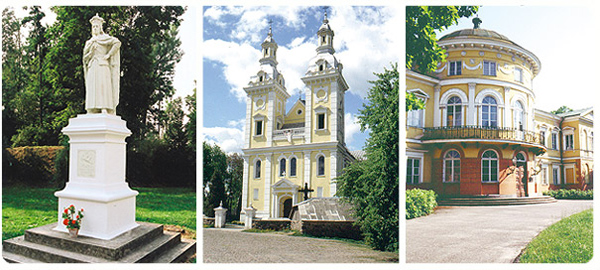|

|
| Ice-house of Burbiškis Manor |
Kleboniškiai village |
Radviliškis
Church of Holy Virgin Mary’s Birth |
INFORMATION
Radviliškis District Tourism and Business Information Centre
Gedimino g. 8, LT-82174 Radviliškis
Tel. +370 422 50128, tel./fax. +370 422 50097
Mob. +370 614 61497, e-mail: turizmas@rtvc.lt
MAIN PLACES OF INTEREST
• Daugyvenė cultural historical museum-preserve. The museum is situated in Pakalniškiai
Neighbourhood, Radviliškis District. Expositions and places of interest are scattered on the banks of
the River Daugyvenė, by the road Šiauliai – Panevėžys.
• Kleboniškiai village ethnographic exposition. The exposition
is situated in a beautiful valley of the River Daugyvenė, 18 ha area of the old village, into which rural buildings characteristic to
the 19th and 20th centuries are moved from the environs: houses, granaries, baths, barns, mows, etc. There are 27
buildings in the village, 18 of which belong to the museum. Old trees and
straw-roofs of houses in the village give the museum mystery, while its inhabitants – reality. Farmers’ life reconstructed in the
buildings transform the visitors to the late 19th century. There is an operating rural bath. The exposition includes
jars, weighing instruments, churns, oven peels, flax combs, collections of motors,
a tractor manufactured in 1926, locomobile produced in the end of the 19th century in England.
• Exposition of the history of Burbiškis Manor. The exposition
is housed in the old Baženskiai manor, which was mentioned in historical source since the 17th century. Manor park of landscape
type, occupying 28 ha area, boasts impressive ponds with 15 islands. Manor buildings are laid out in a way to form a big
closed courtyard, therefore the manor reminds a fortress. Restored guests’ building of the manor houses a
guesthouse, exposition of the history of the manor is founded in the veranda of
the manor. Ice-house of the manor houses a banquet hall. The park has a big number of sculptor Kazimieras Ulianskas’ works:
Monument to poet Adam Mickiewicz (1911), Monument to the Grand Duke of Lithuania Vytautas (1912),
sculpture of Holy Virgin Mary, grand park gate, lions’ bridge. Paths are laid in the
park, islands of the ponds are connected by 12 bridges. A great variety of plants grow in the park flower garden. The manor is
under restoration.
• Ragigėnai complex of Archaeological monuments. Finds of Ragigėnai archaeological monuments
were given the name of “Ragigėnai Culture” in the end of the 19th century. A number of
well-known archaeologists visited and worked here. Fort-hills and ancient settlements, burial mounds, ancient burials,
mythological stones survived till nowadays. The most important object is
Ragigėnai fort-hill wrapped in legends and stories which is also called Witches’ Hill.
|

|
| |
Šeduva Church of
the Discovery of Holy Cross |
Baisogala palace |
• Šeduva Church of the Discovery of Holy Cross is situated at
Vilniaus g. 16, Šeduva, Radviliškis District. Renaissance brick church was built in 1649, it has Baroque features, cross plan,
with semicircular upside, low-ceiled sacristies, two towers. There are 3 naves, 5 altars in the church. It has cylindrical vaults. The
church has stone-fenced courtyard, in which Dean Prelate M. Karosas (1878 – 1955), priest Augustinas Pronskietis (1886
– 1986) are buried.
• Radviliškis Church of Holy Virgin Mary’s Birth is situated at
Maironio g. 8, Radviliškis. The brick church was installed in 1945.Radviliškis Catholic church and parish school were mentioned in
1597. In 1619, a parish was established. It received a land plot in the town for building a school and parsonage, and establishing
an orphanage. Priest K. Ausėnas together with parishioners built a new wooden church in 1769, In 1789, it was consecrated
by priest Adomas Koscia. In 1868, the church was destroyed by fire. In 1870, Dean Juozapas Bortkevičius took care of reconstructionof the church. It was of cross plan, with slim towers. The
church was burnt down during the World War II. In 1945, it was opened in a brick building constructed by German prisoners of
war. The church was reconstructed in 1991. 5 stage bell-tower of folk architecture shapes built in 1876 is preserved. Adjacent to
the church, there are Three crosses in commemoration of those who did not come back from exile. The author of this composition
is V. Vaicekauskas.
• Baisogala palace. The palace was built in the second half of
the 19th century under the rule of Komarai. Later on, the palace was expanded. In the end of the 19th century – beginning of
the 20th century, south-eastern wing was built, in 1911 – 1912 – north-western wing and gallery – terrace attached to western
facade. Interior of the palace was anew planned in about 1963. The palace was restored according to the design of architect of
Design and Construction Institute G. Krikščiūnaitė. In 1982, the interior of the palace was restored. The palace stands on a hill,
the main facade faces the East. The palace is two-storey, brick, plastered, low tin-plated roof, wooden ceiling.
|




